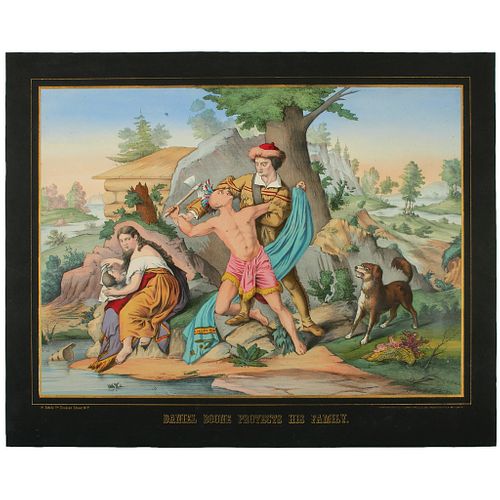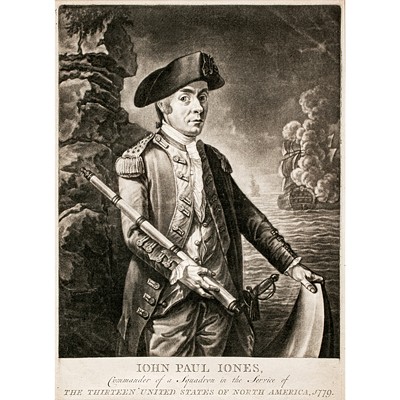1874 DANIEL BOONE PROTECTS HIS FAMILY - Color Lithograph by H. Schile
Lot 244
Categories
Estimate:
$600 - $900
Absentee vs Live bid
Two ways to bid:
- Leave a max absentee bid and the platform will bid on your behalf up to your maximum bid during the live auction.
- Bid live during the auction and your bids will be submitted real-time to the auctioneer.
Bid Increments
| Price | Bid Increment |
|---|---|
| $0 | $10 |
| $200 | $20 |
| $300 | $25 |
| $500 | $50 |
| $1,000 | $100 |
| $2,000 | $200 |
| $3,000 | $250 |
| $5,000 | $500 |
| $10,000 | $1,000 |
| $20,000 | $2,000 |
| $30,000 | $2,500 |
| $50,000 | $5,000 |
| $100,000 | $10,000 |
| $200,000 | $20,000 |
| $300,000 | $25,000 |
| $500,000 | $50,000 |
About Auction
By Early American History Auctions
Jan 23, 2021
Set Reminder
2021-01-23 12:00:00
2021-01-23 12:00:00
America/New_York
Bidsquare
Bidsquare : Early American History Auction of Autographs, Americana, Political & Maps
https://www.bidsquare.com/auctions/early-american-history-auctions/early-american-history-auction-of-autographs-americana-political-maps-6311
311 Lots of Rare, Historic Autographs, Americana, Civil War Era, George Washington, Abraham Lincoln, Slavery & Black History, Revolutionary War Era, Colonial America, Federal Period, War of 1812, Colonial Currency, Indian Peace Medals & more... Early American History Auctions auctions@earlyamerican.com
311 Lots of Rare, Historic Autographs, Americana, Civil War Era, George Washington, Abraham Lincoln, Slavery & Black History, Revolutionary War Era, Colonial America, Federal Period, War of 1812, Colonial Currency, Indian Peace Medals & more... Early American History Auctions auctions@earlyamerican.com
- Lot Description
Posters
Vivid "Daniel Boone Protects His Family" Color Lithograph
1874-Dated, Color Lithograph titled, "DANIEL BOONE PROTECTS HIS FAMILY," by H. Schile, 1 Division Street, N Y, Choice Near Mint.
This outstanding, original Daniel Boone color Lithograph is Large Folio in size and measures 28.25" x 22.5" edge to edge. It was produced in 1874 in two versions, one has a white outer border and this version with rich black with gold gilt outline and printed text. Gold-gilt printed text located at the bottom right, just below the thicker gilt border reads: "accordg to acct of Congs in the year 1874 by H Schile in the Office of the Library of Cong in Washington, D.C.". This wonderful 1874 lithograph entitled "Daniel Boone protects his family" is a representative image of Boone as an Indian fighter. Boone was a legend in his own lifetime, especially after an account of his adventures was published in 1784, making him famous in America and Europe. After his death, he was frequently the subject of tall tales and works of fiction. His adventures, both real and legendary, were hugely influential in creating the archetypal Western hero of American folklore. In American popular culture, he is remembered as one of the foremost early frontiersmen, even though the mythology often overshadows the historical details of his life. This superb print is found in nearly every major collection of classic art depicting our American heritage.
Boone's image was often reshaped into the stereotype of the belligerent, Indian-hating frontiersman which was then popular. In John A. McClung's Sketches of Western Adventure (1832), for example, Boone was portrayed as longing for the "thrilling excitement of savage warfare." Boone was transformed in the popular imagination into someone who regarded Indians with contempt and had killed scores of the "savages". The real Boone disliked bloodshed, however. According to historian John Bakeless, there is no record that Boone ever scalped Indians, unlike other frontiersmen of the era. Boone once told his son Nathan that he was certain of having killed only one Indian, during the battle at Blue Licks, although he believed that others may have died from his bullets in other battles. Even though Boone had lost two sons in wars with Indians, he respected Indians and was respected by them. In Missouri, Boone often went hunting with the very Shawnees who had captured and adopted him decades earlier.
- Shipping Info
-
Early American provides in-house worldwide shipping. Please contact us directly if you have questions about your specific shipping requirements.
-
- Buyer's Premium



 EUR
EUR CAD
CAD AUD
AUD GBP
GBP MXN
MXN HKD
HKD CNY
CNY MYR
MYR SEK
SEK SGD
SGD CHF
CHF THB
THB














